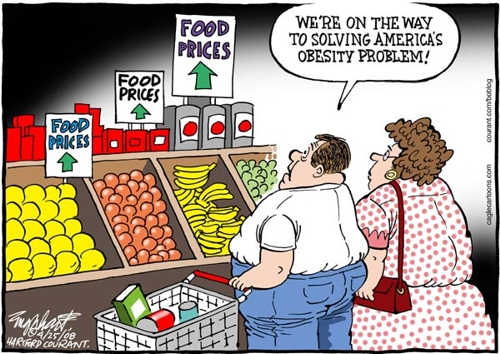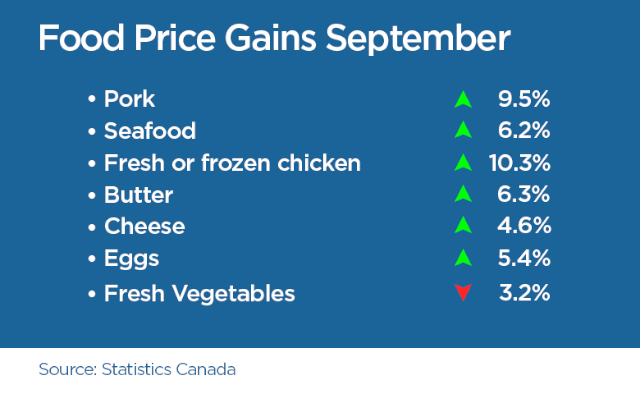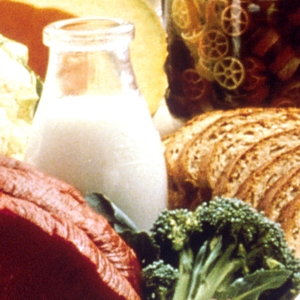Food Prices in Canada rose dramatically last month – along with those in the U.S. and Western European nations. What’s causing the spike? Will prices moderate again? If so, when? It may depend on how soon current supply chain disruptions ease…
 One way to look at it: But, the equation is far more complex than that.
One way to look at it: But, the equation is far more complex than that.
It started with news stories about a shortage of truck drivers as we began to come out of the pandemic. There simply weren’t enough drivers to take all the trucks carrying al the goods – including food – that we all want and need to carry on our lives. Then we started seeing TV images of hundreds of cargo ships just siting off major ports, waiting to be unloaded, due to a shortage of dock workers. Then, toy and appliance companies, among others, started warning that their wares (mostly made in China) will be in short supply over the year-end holidays. The message was, “Shop early or risk missing out.”
And don’t forget about the effects of climate change: Wildfires in Florida and California along with high temperatures across the U.S. South causing persistent droughts also had a major effect on produce supplies. Unoprecedented flooding across Western Europe threw that region’s food supply chain into conniptions.
Shortages drive up prices
It’s a fundamental tenet of economics in capitalist societies: shortages drive up prices. A classic example of this rule arose in the 1890s when all goods had to be man-hauled over the murderous Chillcoot Pass into Gold Country. Scurvy-stricken miners had to pay $20 for a single orange. Everything was similarly crazy-expensive, of course. The result? Storekeepers and goods importers came out of the Rush richer than most of the prospectors.
Now, we hear that Canada’s inflation rate rose 4.4 per cent in September compared with a 4.1 per cent year-over-year increase in August. That’s a lot. And food was a major contributor to the overall increase, up 3.9 per cent year-over-year compared to 2.7 per cent in August.
“Food was an important component of the September increase in inflation, and there were a number of factors that played a role,” Sri Thanabalasingam, senior economist at TD Bank, told Global News. “You had temporary factory closures. You had higher input costs as well as the general theme of supply chain disruptions. So all three factors contributed to pushing up food prices last month.”
Dramatic increases for some foods
Prices of specific foods shot up dramatically last month. Bacon soared 20 percent. Fats and oils rose more than 18 percent. Meats as a group were up 9.5 percent. Dairy products (milk, eggs and butter) increased by an average of 5.4 percent.

Only fresh vegetables dropped in price – and only because the annual harvest was at its peak, and the market was flooded with produce.
When might increases end?
“It’s probably the million-dollar question over when these supply chain disruptions will start fading. From recent reports, it would suggest that maybe sometime in the second half of 2022,” TD bank senior economist Sri Thanabalasingam said. “So until then, you could still see price gains come through as a result of supply issues.”
Other economists concur: They say prices should peak by the end of the year and start coming down again by next summer.
We’ll just have to wait and see…
~ Maggie J.

